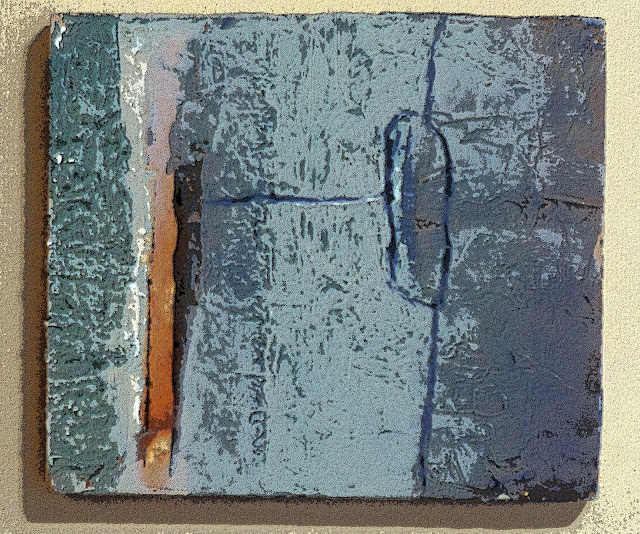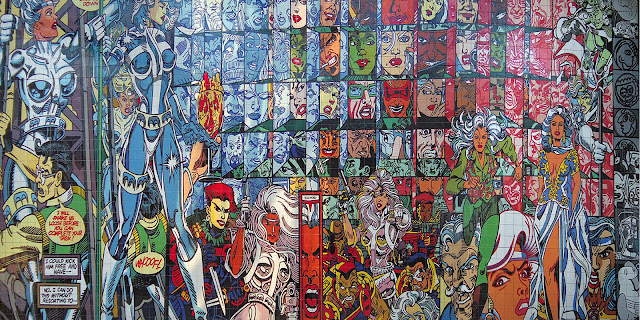This is Chapter 19 of The Inheritance, a serial fiction novel on FITK

Friday Afternoon, July 17, 2020, Seattle
Sean and Mareka had just finished getting his basement storeroom ready for his grandmother’s paintings. They had assembled the racks Sean had bought and he had installed a climate control system to keep the paintings in an optimum environment. The paintings had just been returned after being held in storage in New York since their last exhibition, an event which had been shut down by the Covid-19 pandemic in the spring. Sean was eager to see their condition, and to get Mareka’s impressions. They went up to the garage where the shipping crates that held the paintings had been dropped off.
“Let’s see what we’ve got here,” said Sean, as he opened the first of the crates. The paintings had been carefully wrapped in Tyvek and there was no sign of trauma to the canvases. He began to unwrap them, positioning them around the perimeter of the garage so that they could get a good look at them, and taking pictures to inventory their condition. He had a stick of sidewalk chalk that he used to write the work number on the garage floor in front of them. Mareka, looking in wide-eyed wonder as they were revealed, had a strange sensation, similar to what she felt when she visited the ‘Power Centers’ in Iowa after her great-aunt’s funeral.
“These are so cool!” said Mareka, “I feel like Emily is talking to me!”
“It’s good to have them back, to have them ‘home’, as it were,” said Sean, “Here’s another piece of chalk, write an ‘x’ on the floor in front of the ones you like the best and we can put them up in the house.”
“I like them all!” said Mareka, “Can I have one for my room? I have room above my bed.”
“Certainly, one of the smaller ones will fit there,” said Sean, “Emily will be looking over you as you sleep.”
“How is it coming along?” said Mary, who had just entered the garage, and was surveying the expanding collection. “That’s quite a big job!”
“This is fun!“ said Mareka, “Pops said I can have one for my room.”
Mary smiled. She was glad to see Mareka happy. The last several months had been hard on all of them, and Mary had been very concerned that Mareka was in danger of losing what was left of her childhood innocence in the face of recent events. Mareka’s growing awareness of her powers was, potentially, an additional source of conflict.
“How about you, Mary, anything that catches your eye?” said Sean, as he opened the second crate, “Something for the living room?”
“You choose, but pick a couple with a lot of color,” said Mary, “I’m ready to move on from the monochrome look of our old apartment. It’s a new decade, after all. We’ve got some nice perennials blooming in the garden and I’m going to fill the house with flowers.”
Mareka had moved over to the last canvas Sean had unwrapped. “This is the one for my room,” she said, marking the floor in front of it: XXX.
Spokane, Friday Afternoon, July 17, 2020
Jo was too late; her mother was dead. The EMT’s, who had been first responders, had told her that it was obvious that her mother had died hours earlier, probably not long after Jo had last spoken with her. They told her not to touch the body, not to stay in the same room, and that she should stay outside if at all possible. The police came soon after and took down Jo’s information for their report. After they left, Jo went back to the bedroom and found the loaded 32 caliber handgun that her mother had always kept in her nightstand. She put it in her purse.
Jo was waiting for the coroner to arrive. As she sat on the front porch, Jo pondered her next moves. Her mother’s estate, except for the house, was probably worth nothing; Jo had given her mother money several times in the past couple of years. Her mother did have a lawyer, however, a family friend who had helped out when Jo’s ex was threatening Jo. Jo contacted the lawyer and he said he would start the paperwork to wrap up her estate. There was nothing left for her in Spokane, she thought, only bad memories and wasted opportunities. In Seattle she had a small circle of friends—including Sean and Mary, of course. And then there was Mareka. In a few years Mareka would be leaving her behind, it was already obvious to Jo that Mareka would be carrying on in the tradition of her Mother and her great-grandmother. Sean and Mary were winding down their businesses so Jo wondered how much longer they would be in need of her help. Her mother’s demise—dying sick and alone—made Jo think that it was a preview of what hers would be.
And that thought made Jo sad.
Friday Afternoon, July 17, 2020, Seattle
Barbara Merrit had been sitting on a park bench near the Green Lake wading pool, waiting for her meeting with the mysterious ‘Marcel DuPage’. He had emailed her, offering information on Sean Carroll and Mary Robinson. An older man with white hair and flamboyantly dressed in a vivid floral print shirt with a scarlet-lined cape, came strolling up.
“I take it that you are Marcel,” said Barbara, “You were correct in saying that I’d notice you.”
“Ms Merrit, I presume,” said Marcel, sitting down beside her, “I’m so very glad to see you. Thanks for meeting with me.”
“Well, shall we get right down to it? What do you have for me, and what can I do for you?”
“I’ll assume that you are familiar with all the media coverage from about seven years ago concerning Sean Carroll and Mary Robinson,” began Marcel, “Feel free to interrupt if you have any questions,” said Marcel, pausing to wipe his glasses, “I run, or I should say,
ran a dance studio specializing in ballroom styles. We would have weekly dances, very popular at the time, I liked to think of them a island of class in an ocean of grunge. At one of these events, in Saturday the 13th, October 2012, I met a young couple, a couple whom I would later learn to be Sean Carroll and Mary Robinson. Are you following me?”
“Yes, of course,” said Barbara, “That was the same time-frame as when my late brother was conducting his investigation. Please continue.”
“Now accompanying the young couple that evening was an older woman—closer to my age—who wore a stunning vintage high-fashion dress, a Schiaparelli, probably from the 1930s. We ‘hit it off.’ Without going into intimate detail, let me just say that… we shared breakfast in the morning. Now, you might well be asking yourself, what does all this have to do with Sean and Mary?”
“Yes I am, please continue,” said Barbara, who had found herself caught up in the Marcel’s enthusiastic telling of the story.
“You will also recall that about this time Sean inherited a large quantity of artwork that had been created by his grandmother, Emily Carroll, in the 1920s and 30s.”
“Indeed, that is one of the things I’m interested in.”
“Now… this is the difficult part of my story… I have reason to believe that my mysterious dance partner and Sean’s grandmother, Emily, were one and the same person. I can’t explain it, she would have been over 110 years old if she had been still alive, certainly not up to dancing the night away with someone less than half her age, much less staying over. After our interlude, I bagged up her dress, she borrowed some clothes, took a taxi to Pike Place Market, and I never saw her again. I placed personal ads about her for weeks. It was not until much later, when Sean published his book about her and began to exhibit her art work, that I made a connection,” Marcel wiped his brow with a monogrammed kerchief, “I was wondering if you, in your research, have come across any pictures or other evidence from that time that would help explain this mystery.”
“I do have images, I have copies of all my brother’s files from that time, right here on my iPad,” said Barbara as she opened the device and began to search, “You said October 13th?”
“Yes, that’s the date.”
“Here we are,” said Barbara as she scrolled to that day’s folder, “2012-10-13.”
There were dozens of images, some of Sean, some of Mary, some of both of them. But when Barbara scrolled to exposures taken at night outside of Marcel’s ballroom, he barked “STOP!”
One of the images showed Sean, walking arm-in-arm with Mary and, on his other side, arm-in-arm with an older woman, a woman wearing a stylish red dress. The familial resemblance between Sean and the woman was striking.
"That’s her. Emily Carroll,” said Marcel, “Would you be so kind as to send me those pictures, and any other ones with Emily in them?”
Next chapter: Social Distance





















